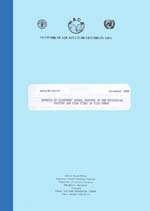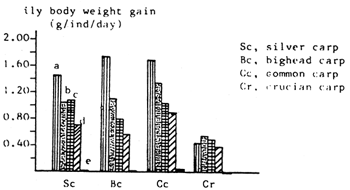
FACTORS AND FISH YIELD IN FISH PONDS
| NACA/WP/88/67 | December 1988 |
 | EFFECTS OF DIFFERENT ANIMAL MANURES ON THE ECOLOGICAL FACTORS AND FISH YIELD IN FISH PONDS |
Fang Yingxue, Guo Xianzhen, Wang Jikun,
Yang Yejin, Yang Yaping and Liu Zhiyun
Hyperlinks to non-FAO Internet sites do not imply any official endorsement of or responsibility for the opinions, ideas, data or products presented at these locations, or guarantee the validity of the information provided. The sole purpose of links to non-FAO sites is to indicate further information available on related topics.
This electronic document has been scanned using optical character recognition (OCR) software. FAO declines all responsibility for any discrepancies that may exist between the present document and its original printed version.
ABSTRACT
Different animal manures were used in the experiment. Fish yield of the chicken-manured pond was the highest, followed by that of the duck-manured pond, the pig-manured pond and the cow-manured pond. The factors which affected the fish yield were the inorganic nitrogen, phosphorus, and the biomass of zooplankton and phytoplankton.
INTRODUCTION
Chen Qiyu (1982), He Zhihui et al., (1983), Lei Yanzhi et al., (1983) and Schroeder (1978) have studied the dynamics of ecological factors and fish yields in manured ponds.
This experiment was conducted to determine the changes in the major ecological factors in the water column after applying 4 different animal manures, and the effects of the applications on fish yields.
METHODS
The experiment lasted for 118 days. Fish were reared in 10 cement ponds (66.7 m2, water 0.8 m deep), two of each kind of fresh manure, and two for control. Fish species and stocking weight are shown in Table 1.
Ponds were applied with fresh manure once a week. The manuring rate was 21% (dry weight basis) of the fish biomass for the first time; it was increased gradually every month. Major ecological factors were determined for 7 consecutive days after manure application on the first week of every month, including water temperature, pH, transparency, DO, BOD, total nitrogen, ammonia nitorgen, nitrate nitrogen, nitrite nitrogen, phosphate, aerobic heterotrophic bacteria, total bacteria, phytoplankton, zooplankton and suspended matter.
Table 1. Stocking and harvesting of the experimental ponds.
| Pond | Fish spp. | Stocking | Harvesting | |||
| ind. | weight (kg) | ind. | weight (kg) | |||
| Chicken-manured pond | SC* | 45 | 2.2 | 38 | 8.5 | |
| BH* | 10 | 0.5 | 10 | 2.6 | ||
| CC* | 15 | 0.3 | 15 | 3.3 | ||
| CR* | 30 | 1.9 | 29 | 3.4 | ||
| Duck-manured pond | SC | 45 | 2.2 | 44 | 7.6 | |
| BH | 10 | 0.5 | 10 | 1.8 | ||
| CC | 15 | 0.3 | 14 | 2.5 | ||
| CR | 30 | 1.9 | 30 | 3.6 | ||
| Pig-manured pond | SC | 45 | 2.0 | 45 | 7.9 | |
| BH | 10 | 0.5 | 10 | 1.5 | ||
| CC | 15 | 0.3 | 13 | 1.9 | ||
| CR | 30 | 1.9 | 30 | 3.6 | ||
| Cow-manured pond | SC | 45 | 1.9 | 44 | 5.5 | |
| BH | 10 | 0.4 | 10 | 1.1 | ||
| CC | 15 | 0.3 | 14 | 1.8 | ||
| CR | 30 | 1.9 | 30 | 3.6 | ||
| Control pond | SC | 45 | 1.9 | 31 | 1.6 | |
| BH | 10 | 0.5 | 8 | 0.4 | ||
| CC | 15 | 0.4 | 14 | 0.4 | ||
| CR | 30 | 1.9 | 30 | 1.6 | ||
* SC = silver carp;
BH = bighead;
CC = common carp;
CR = crucian carp
RESULTS
The weight at harvest is shown in Table 1. The average values of the major ecological factors are shown in Table 2.
Table 2. Major ecological factors of the experimental ponds
| Pond | Chicken-manured | Duck-manured | Pig-manured | Cow-manured | Control |
| DO (mg/L) | 8.6+4.4 | 9.6+5.0 | 8.8+2.3 | 11.3+5.6 | 12.4+1.4 |
| BOD (mg/l) | 5.8+2.9 | 4.8+1.4 | 4.1+1.0 | 4.2+1.1 | 1.9+1.1 |
| Inorganic N (mg/l) | 2.275 | 0.995 | 0.958 | 0.879 | 0.642 |
| Phosphate (mg/l) | 0.434 | 0.094 | 0.067 | 0.024 | 0.019 |
| Detritus (mg/l) | 71.00 | 61.96 | 52.57 | 64.44 | 43.34 |
| Phytoplankton (mg/l) | 38.7+19.5 | 22.66.9 | 20.6+6.2 | 19.2+6.5 | 12.88.3 |
| Zooplankton (mg/l) | 18.5+17.5 | 6.3+6.1 | 7.8+7.7 | 5.6+3.8 | 1.6+0.9 |
| Aerobic heterotrophic bacteria (ind/ml) | 7.9×103 | 5.8×103 | 3.9×103 | 4.2×103 | 0.9×103 |
DISCUSSION
The fish yield of the chicken-manured pond was the highest, followed by that of the duck-manured pond, the pig-manured pond and the cow-manured pond. The conversion factors of the chicken manure, duck manure, pig manure and cow manure were 2.05, 2.09, 2.17 and 3.15 in dry weight, respectively. Fig. 1. shows the effects of four types of animal manures on the growth rates of the four fish species.

Fig. 1. Fish growth rates with four animal manures: a, Chicken; b, Duck; c, Pig; d. Cow and e. Control
The higher amounts of inorganic nitrogen, phosphorus, zooplankton and phytoplankton in the fish pond resulted in a higher fish yield (Table 1, 2). The relationship between the major ecological factors were in the multiple linear regression equation, (n = 108), e.g. chicken-manured pond (r = 0.624), Y = 75.5260-0.324x1-12.3695x2 - 0.3125x3 - 0.475x4.
Where, Y is the biomass of phytoplankton. x1, x2, x3 and x4 represent inorganic nitrogen, bacteria, zooplankton and water temperature, respectively.
REFERENCES
Chen Qiyu et al, 1982. J. of Fisheries of China, 6(4);331.
He Zhuhui et al, 1983. J. of Fisheries of China, 67(4):287.
Lei Yanzhi et al, 1983. J. of Fisheries of China, 7(3): 185.
Schroeder G.L., 1978. Aquaculture, 14:303.
ACKNOWLEDGEMENTS
We thank Dr. Brian F. Davy of IDRC, Mr. Chen Foo Yan of NACA for financial support and assistance and Zhu Lingeng, Liu Meizhen, Fang Siuzhen, Ni Rufeng, Li Peizhen and the staff of the water chemistry group of FFRC for their help in the experiment.
